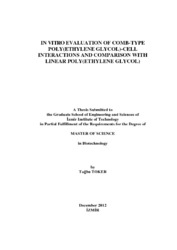Please use this identifier to cite or link to this item:
https://hdl.handle.net/11147/3558Full metadata record
| DC Field | Value | Language |
|---|---|---|
| dc.contributor.advisor | Bulmuş Zareie, Esma Volga | en |
| dc.contributor.author | Toker, Tuğba | - |
| dc.date.accessioned | 2014-07-22T13:51:48Z | - |
| dc.date.available | 2014-07-22T13:51:48Z | - |
| dc.date.issued | 2012 | en |
| dc.identifier.uri | http://hdl.handle.net/11147/3558 | - |
| dc.description | Thesis (Master)--Izmir Institute of Technology, Biotechnology, Izmir, 2012 | en |
| dc.description | Includes bibliographical references (leaves: 55-60) | en |
| dc.description | Text in English; Abstract: Turkish and English | en |
| dc.description | xi, 76 leaves | en |
| dc.description.abstract | The aim of this study is to investigate physicochemical characteristics and in vitro cell interactions of comb-type poly(ethylene glycol) (Mn= 10 700 and Mn= 20 200 g/mol, p(PEG-A) 10K and p(PEG-A) 20K, respectively) in comparison with linear poly(ethylene glycol) (Mn= 10 000 and Mn= 20 000 g/mol, PEG 10K and PEG 20K, respectively) of equivalent molecular weight. In vitro cytotoxicity, cell uptake and intracellular distribution profile of comb-type and linear polymers were investigated using human lung adenocarcinoma epithelial cells (A549). The dynamic light scattering (DLS) analysis showed that the comb-type polymers had smaller hydrodynamic diameters (Dh) (4.5±0.3 nm - 5.9±0.3 nm) than linear PEGs (5.6±0.5 nm - 7.8 ±0.2 nm) in water and phosphate buffer solution at pH 7.4. While the Dh of p(PEG-A) 10K and 20K in RPMI 1640 and RPMI 1640 containing 10% FBS ranged between 44.4±1.8 nm and 58±5.3 nm, the Dh of PEG 10K and 20K in the same media were between 54.5±4.7 nm and 63.5±2 nm. According to the AFM analysis, PEG 10K forms supramolecular linear structures whereas p(PEG-A) 10K forms spherical structures. None of the polymers caused significant cytotoxic effect on A549 cells under the conditions tested via a cell viability assay. Cell uptake studies via flow cytometry showed that the uptake of p(PEG-A) 10K by A549 cells was significantly higher than the other polymers tested. All polymers were internalized by A549 cells via an active transport mechanism. The uptake increased with increasing polymer concentrations. None of the polymers affected the cell cycle of A549 cells under the conditions tested. Both the comb-type and linear PEGs were found to localize in the lysosomes of A549 cells. | en |
| dc.language.iso | en | en_US |
| dc.publisher | Izmir Institute of Technology | en |
| dc.rights | info:eu-repo/semantics/openAccess | en_US |
| dc.subject.lcsh | Polyethylene glycol | en |
| dc.subject.lcsh | Polyethylene oxide | en |
| dc.subject.lcsh | Drug carriers (Pharmacy) | en |
| dc.subject.lcsh | Controlled release preparations | en |
| dc.subject.lcsh | Cell interaction | en |
| dc.title | In vitro evaluation of comb-type poly (ethylene glycol) - cell interactions and comparison with linear poly (ethylene glycol) | en_US |
| dc.type | Master Thesis | en_US |
| dc.institutionauthor | Toker, Tuğba | - |
| dc.department | Thesis (Master)--İzmir Institute of Technology, Bioengineering | en_US |
| dc.relation.publicationcategory | Tez | en_US |
| item.openairecristype | http://purl.org/coar/resource_type/c_18cf | - |
| item.cerifentitytype | Publications | - |
| item.fulltext | With Fulltext | - |
| item.languageiso639-1 | en | - |
| item.grantfulltext | open | - |
| item.openairetype | Master Thesis | - |
| Appears in Collections: | Master Degree / Yüksek Lisans Tezleri | |
Files in This Item:
| File | Description | Size | Format | |
|---|---|---|---|---|
| T001091.pdf | MasterThesis | 1.95 MB | Adobe PDF |  View/Open |
CORE Recommender
Page view(s)
60
checked on Apr 15, 2024
Download(s)
68
checked on Apr 15, 2024
Google ScholarTM
Check
Items in GCRIS Repository are protected by copyright, with all rights reserved, unless otherwise indicated.